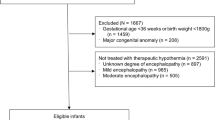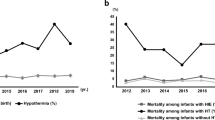Abstract
Objective
Blood product transfusion is a common practice in infants with hypoxic-ischemic encephalopathy (HIE) undoing therapeutic hypothermia (TH). The advantages and disadvantages of conservative or liberal transfusion practices in this fragile population are unknown. Study aims to characterize the transfusion practices in infants with HIE and investigate the association with outcome.
Study design
We conducted a retrospective cohort study at a single level IV NICU, evaluating transfusion thresholds, as well as the association between hematological abnormalities or blood product transfusions and outcomes in infants admitted with HIE.
Result
By univariate analysis, FFP transfusion was associated with increased in-hospital death. However, multivariate analysis adjusting for HIE severity demonstrated no association between hematological abnormality or blood product transfusion and death, nor with neurodevelopmental impairment.
Conclusion
No association was found between hematological blood product transfusion and death or neurodevelopmental impairment in a retrospective single NICU study of infants with HIE.
This is a preview of subscription content, access via your institution
Access options
Subscribe to this journal
Receive 12 print issues and online access
$259.00 per year
only $21.58 per issue
Buy this article
- Purchase on SpringerLink
- Instant access to full article PDF
Prices may be subject to local taxes which are calculated during checkout

Similar content being viewed by others
Data availability
Summarized and de-identified data will be made available upon reasonable request.
References
Gluckman PD, Wyatt JS, Azzopardi D, Ballard R, Edwards AD, Ferriero DM, et al. Selective head cooling with mild systemic hypothermia after neonatal encephalopathy: multicentre randomised trial. Lancet. 2005;365:663–70. https://doi.org/10.1016/S0140-6736(05)17946-X.
Pierrat V, Haouari N, Liska A, Thomas D, Subtil D, Truffert P, et al. Prevalence, causes and outcome at 2 years of age of newborn encephalopathy: population based study. Arch Dis Child Fetal Neonatal Ed. 2005;90:F357–261. https://doi.org/10.1136/adc.2003.047985.
Shankaran S, Laptook AR, Ehrenkranz RA, Tyson JE, McDonald SA, Donovan EF, et al. Whole-body hypothermia for neonates with hypoxic-ischemic encephalopathy. N Engl J Med. 2005;353:1574–84. https://doi.org/10.1056/NEJMcps050929.
Azzopardi D, Brocklehurst P, Edwards D, Halliday H, Levene M, Thoresen M, et al. The TOBY study. Whole body hypothermia for the treatment of perinatal asphyxia encephalopathy: A randomised controlled trial. BMC Pediatr. 2008;8:17 https://doi.org/10.1186/1471-2431-8-17.
Azzopardi DV, Strohm B, Edwards D, Dyet L, Halliday HL, Juszczak E, et al. Moderate hypothermia to treat perinatal asphyxial encephalopathy. N Engl J Med. 2009;361:1349–58. https://doi.org/10.1056/NEJMoa0900854.
Gunn AJ, Thoresen M. Neonatal encephalopathy and hypoxic-ischemic encephalopathy. Handb Clin Neurol. 2019;162:217–37. https://doi.org/10.1016/B978-0-444-64029-1.00010-2.
Robertson CM, Finer NN, Grace MG. School performance of survivors of neonatal encephalopathy associated with brain asphyxia at term. J Pediatr. 1989;114:753–60. https://doi.org/10.1016/s0022-3476(89)80132-5.
Odd DE, Gunnell D, Lewis G, Rasmussen F. Long term impact of poor birth condition on social and economic outcomes in early outcomes in early adulthood. Pediatrics. 2011;127:e1498–e1504. https://doi.org/10.1542/peds.2010-3604.
Forman KR, Diab Y, Wong EC, Baumgart S, Luban NL, Massaro AN. Coagulopathy in newborns with hypoxic ischemic encephalopathy (HIE) treated with therapeutic hypothermia: a retrospective case-control study. BMC Pediatr. 2014;14:277 https://doi.org/10.1186/1471-2431-14-277.
Pakvasa MA, Winkler AM, Hamrick SE, Josephson CD, Patel RM. Observational study of haemostatic dysfunction and bleeding in neonates with hypoxic-ischaemic encephalopathy. BMJ Open. 2017;6:e013787 https://doi.org/10.1136/bmjopen-2016-013787.
Beltempo M, Wintermark P, Mohammad K, Jabbour E, Afifi J, Shivananda S, et al. Variations in practices and outcomes of neonates with hypoxic ischemic encephalopathy treated with therapeutic hypothermia across tertiary NICUs in Canada. J Perinatol. 2022;42:898–906. https://doi.org/10.1038/s41372-022-01412-7.
Keir AK, McPhee AJ, Andersen CC, Stark MJ. Plasma cytokines and markers of endothelial activation increase after packed red blood cell transfusion in the preterm infant. Pediatr Res. 2013;73:75–79. https://doi.org/10.1038/pr.2012.144.
Curley A, Stanworth SJ, Willoughby K, Fustolo-Gunnink SF, Venkatesh V, Hudson C, et al. Randomized trial of platelet-transfusion thresholds in neonates. N Engl J Med. 2019;380:242–51. https://doi.org/10.1056/NEJMoa1807320.
Davenport P, Sola-Visner M. Platelet transfusions in neonates: beyond hemostasis. Arterioscler Thromb Vasc Biol. 2023;43:886–8. https://doi.org/10.1161/ATVBAHA.123.319252.
Davenport P, Sola-Visner M. Immunologic effects of red blood cell and platelet transfusions in neonates. Curr Opin Hematol. 2022;29:297–305. https://doi.org/10.1097/MOH.0000000000000736.
Davenport P, Sola-Visner M. Platelets in the neonate: not just a small adult. Res Pr Thromb Haemost. 2022;6:e12719 https://doi.org/10.1002/rth2.12719.
Maouia A, Rebetz J, Kapur R, Semple JW. The immune nature of platelets revisited. Transfus Med Rev. 2020;34:209–20. https://doi.org/10.1016/j.tmrv.2020.09.005.
Anglin CO, Spence JS, Warner MA, Paliotta C, Harper C, Moore C, et al. Effects of platelet and plasma transfusion on outcome in traumatic brain injury patients with moderate bleeding diathesis. J Neurosurg. 2013;118:676–86. https://doi.org/10.3171/2012.11.JNS12622.
Patel RM, Knezevic A, Shenvi N, Hinkes M, Keene S, Roback JD, et al. Association of red blood cell transfusion, anemia and necrotizing enterocolitis in very low-birth-weight infants. JAMA. 2016;315:889–97. https://doi.org/10.1001/jama.2016.1204.
Kirpalani H, Whyte RK, Andersen C, Asztalos EV, Heddle N, Blajchman MA, et al. The Premature Infants in Need of Transfusion (PINT) study: a randomized, controlled trial of a restrictive (low) versus liberal (high) transfusion threshold for extremely low birth weight infants. J Pediatr. 2006;149:301–7. https://doi.org/10.1016/j.jpeds.2006.05.011.
Williams MD, Chalmers EA, Gibson BES. The investigation and management of neonatal haemostasis and thrombosis. Br J Haematol. 2002;119:295–309. https://doi.org/10.1046/j.1365-2141.2002.03674.x.
Gunnink SF, Vlug R, Fijnvandraat K, van der Bom JG, Stanworth SJ, Lopriore E. Neonatal thrombocytopenia: etiology, management and outcome. Expert Rev Hematol. 2014;7:387–95. https://doi.org/10.1586/17474086.2014.902301.
Hochart A, Pierache A, Jeanpierre E, Laffargue A, Susen S, Goudemand J. Coagulation standards in healthy newborns and infants. Arch de Pédiatrie. 2021;28:156–8. https://doi.org/10.1016/j.arcped.2020.10.007.
Lau W Neonatal and Pediatric Transfusion. Canadian Blood Services Chapter 13 2017; 1-13.
Balasundaram P, Avulakunta ID Bayley Scales Of Infant and Toddler Development. [Updated 2022 Nov 21]. In: StatPearls [Internet]. Treasure Island (FL): StatPearls Publishing; 2024.
Palisano R, Rosenbaum P, Walter S, Russell D, Wood E, Galuppi B. Development and reliability of a system to classify gross motor function in children with cerebral palsy. Dev Med Child Neurol. 1997;39:214–23. https://doi.org/10.1111/j.1469-8749.1997.tb07414.
Moore CM, D’Amore A, Fustolo-Gunnink S, Hudson C, Newton A, Santamaria BL, et al. Two-year outcomes following a randomised platelet transfusion trial in preterm infants. Arch Dis Child Fetal Neonatal Ed 2023;108:452–7. https://doi.org/10.1136/archdischild-2022-324915.
Davenport P, Fan HH, Nolton E, Feldman HA, Lorenz V, Canas J, et al. Platelet transfusions in a murine model of neonatal polymicrobial sepsis: Divergent effects on inflammation and mortality. Transfusion. 2022;62:1177–87. https://doi.org/10.1111/trf.1689.
Kirpalani H, Bell EF, Hintz SR, Tan S, Schmidt B, Chaudhary AS, et al. Higher or lower hemoglobin transfusion thresholds for preterm infants. N Engl J Med. 2020;383:2639–51. https://doi.org/10.1056/NEJMoa2020248.
Franz AR, Engel C, Bassler D, Rüdiger M, Thome UH, Maier RF, et al. Effects of liberal vs restrictive transfusion thresholds on survival and neurocognitive outcomes in extremely low-birth-weight infants: the ETTNO randomized clinical trial. JAMA. 2020;324:560–70. https://doi.org/10.1001/jama.2020.10690.
Author information
Authors and Affiliations
Contributions
BTK and AAM conceptualized the study. AAM, MS, and AD collected the data. AAM, MS, MS, KR, and CSF analyzed the data. BTK, AAM, MS, and MNC wrote the manuscript, which was then reviewed and edited by AES, RY, and LL.
Corresponding author
Ethics declarations
Competing interests
The authors declare no competing interests.
Ethics approval and consent to participate
All methods were performed in accordance with regulations from the Research Ethics Board at the Hospital for Sick Children. This study was approved by The Hospital for Sick Children Research Ethics Board (# 1000079302), which granted a waiver of informed consent given the retrospective nature of the study design.
Additional information
Publisher’s note Springer Nature remains neutral with regard to jurisdictional claims in published maps and institutional affiliations.
Supplementary information
Rights and permissions
Springer Nature or its licensor (e.g. a society or other partner) holds exclusive rights to this article under a publishing agreement with the author(s) or other rightsholder(s); author self-archiving of the accepted manuscript version of this article is solely governed by the terms of such publishing agreement and applicable law.
About this article
Cite this article
Miran, A.A., Stoopler, M., Cizmeci, M.N. et al. Blood product transfusion practices in neonates with hypoxic-ischemic encephalopathy. J Perinatol 44, 1485–1490 (2024). https://doi.org/10.1038/s41372-024-02092-1
Received:
Revised:
Accepted:
Published:
Issue date:
DOI: https://doi.org/10.1038/s41372-024-02092-1



